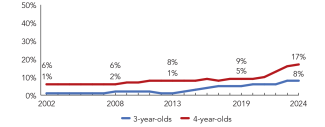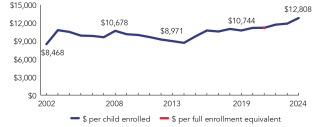
State of Preschool
Washington
Access Rankings
Resource Rankings
Total Benchmarks Met
Overview

During the 2023-2024 school year Washington’s Department of Children, Youth, and Families (DCYF) enrolled 16,293 children in the Early Childhood Education and Assistance Program (ECEAP), an increase of 485 children from the prior year. State spending for ECEAP totaled $207,900,614, up $26,968,975 (15%), adjusted for inflation, since last year. State spending per child on ECEAP averaged $12,760 in 2023-2024, up $1,315 from 2022-2023, adjusted for inflation. Washington ECEAP met 9 of 10 quality standards benchmarks.
Washington’s Office of Superintendent of Public Instruction (OSPI) also served 5,520 children in a Transition to Kindergarten (TK) program during the 2023-2024 school year, an increase of 276 children from the prior year. State spending for TK was $29,632,532 and an additional $41,848,000 in federal recovery funds supported the program, an increase of $2,293,273 (3%), adjusted for inflation, since last year. State spending per child on TK was $12,949 (including recovery funds), down $244 from 2022-2023, adjusted for inflation. TK met 6 out of 10 quality standards benchmarks.
What's New

ECEAP added 500 more slots in 2023-2024 and another 1,000 in 2024-2025 as well as 1,000 part- to school-day conversions. In 2023- 2024 contractors received slot rate increases: 18% for school-day slots, 9% for working-day slots, and 7% for part-day slots. Income eligibility categories will increase again in 2030-2031. The state QRIS implemented a revised quality recognition and improvement system based on provider feedback that moves to a virtual data collection model that allows reviewers the opportunity to see every teaching environment and engage in coaching with teachers.
Transitional Kindergarten was codified by the legislatures as Transition to Kindergarten and OSPI published new rules and guidance for the 2024-2025 school year to set minimum standards and requirements for TK. DCYF and OSPI are supporting TK programs with TA on collaborating with community-based partners (including ECEAP), Head Start, child care, family child care, and licensed tribally-led early learning programs. DCYF and OSPI jointly identified strategies to improve alignment of high quality preschool across the two agencies and increase equitable access to preschool.
In September 2024, Washington was one of 10 states and D.C. awarded a 3-year federal renewal Preschool Development Grant B-5 (PDG B-5) totaling $7,996,674 annually. The grant will expand early care and education by increasing 75 slots in the B-3 ECEAP program for infants and toddlers, as well as improve resource coordination, provide free classroom curriculum, enhance professional development, support mental health services for ECE providers, and further other critical initiatives.
Background
The Department of Children, Youth, and Families (DCYF) oversees early learning programs along with child welfare and juvenile rehabilitation. DCYF prioritizes the creation of a high-quality integrated birth to eight system, which includes expanding access to affordable, high-quality care that is both responsive and inclusive. ECEAP, created in 1985, is a large part of the state’s strategy to accomplish this goal. In 2010, the state Legislature established the ECEAP as a statutory entitlement for all eligible children, not funded by Head Start, with an extension to 2026-2027. ECEAP focuses on the whole child, providing nutrition, health, education, and family support services to at-risk young children. To be eligible, children must be 3- or 4-years-old and meet specific income or special circumstance criteria such as eligible for special education services or experiencing homelessness. Up to 10% of ECEAP enrollment can include children whose families do not meet the income requirement but face other risk factors that are linked to development or school success.
The Office of Superintendent of Public Instruction (OSPI) is the primary agency charged with overseeing public K–12 education in Washington state. Working with the state’s 295 public school districts and six state-tribal education compact schools, OSPI allocates funding and provides tools, resources, and technical assistance so every student in Washington is provided a high-quality public education. The goal of Washington’s K–12 education system is to prepare every student for postsecondary pathways, careers, and civic engagement.
OSPI’s Transition to Kindergarten (TK) is a legislatively established and authorized program for children who are at least 4-years-old by August 31 and have been identified through a screening process to be in need of additional preparation to be successful kindergarten students in the following school year. Districts may offer TK programs, but they are not required to do so. The requirements for TK are outlined in the Washington State Administrative Code (WAC) Chapter 392-425. TK has gained momentum in recent years, as a strategy for closing opportunity gaps.
-
Access

Total state pre-K enrollment 21,813 Special education enrollment, ages 3 and 4 11,104 Federally funded Head Start enrollment, ages 3 and 4 7,958 State-funded Head Start enrollment, ages 3 and 4 0 Resources
Total state pre-K spending $279,381,146 State Head Start spending $0 State spending per child enrolled $12,808 All reported spending per child enrolled* $13,013 
*Pre-K programs may receive additional funds from federal or local sources that are not included in this figure. †Head Start per-child spending includes funding only for 3- and 4-year-olds. ‡K–12 expenditures include capital spending as well as current operating expenditures.
-
Access
Resources
Total state pre-K spending $207,900,614 Local match required? No State spending per child enrolled $12,760 All reported spending per child enrolled* $12,760 
*Pre-K programs may receive additional funds from federal or local sources that are not included in this figure. †Head Start per-child spending includes funding only for 3- and 4-year-olds. ‡K–12 expenditures include capital spending as well as current operating expenditures.
Washington Early Childhood Education and Assistance Program (ECEAP) Quality Standards Checklist
| Policy | WA ECEAP Requirement | Benchmark | Meets Benchmark? |
|---|---|---|---|
For more information about the benchmarks, see the Executive Summary and the Roadmap to State pages. | 9benchmarks met | ||
| Early Learning & Development Standards Benchmark | Comprehensive, aligned, supported, culturally sensitive | Comprehensive, aligned, supported, culturally sensitive | |
| Curriculum Supports Benchmark | Approval process & supports | Approval process & supports | |
| Teacher Degree Benchmark | AA | BA | |
| Teacher Specialized Training Benchmark | ECE, CD, ECE SpEd | Specializing in pre-K | |
| Assistant Teacher Degree Benchmark | CDA | CDA or equivalent | |
| Staff Professional Development Benchmark | 20 hours/year (teachers), 15 hours/year (assistants); PD plans; Coaching | For teachers & assistants: At least 15 hours/year; individual PD plans; coaching | |
| Maximum Class Size Benchmark | 20 (3- & 4-year-olds) | 20 or lower | |
| Staff to Child Ratio Benchmark | 1:10 (3- & 4-year-olds) | 1:10 or better | |
| Screening & Referral Benchmark | Vision, hearing, health & more | Vision, hearing & health screenings; & referral | |
| Continuous Quality Improvement System Benchmark | Structured classroom observations; Data used for program improvement | Structured classroom observations; data used for program improvement | |
-
Access
Resources
Total state pre-K spending $71,480,532 Local match required? No State spending per child enrolled $12,949 All reported spending per child enrolled* $13,760 
*Pre-K programs may receive additional funds from federal or local sources that are not included in this figure. †Head Start per-child spending includes funding only for 3- and 4-year-olds. ‡K–12 expenditures include capital spending as well as current operating expenditures.
Washington Transitional Kindergarten (TK) Quality Standards Checklist
| Policy | WA TK Requirement | Benchmark | Meets Benchmark? |
|---|---|---|---|
For more information about the benchmarks, see the Executive Summary and the Roadmap to State pages. | 6benchmarks met | ||
| Early Learning & Development Standards Benchmark | Comprehensive, aligned, supported, culturally sensitive | Comprehensive, aligned, supported, culturally sensitive | |
| Curriculum Supports Benchmark | Approval process & supports | Approval process & supports | |
| Teacher Degree Benchmark | BA | BA | |
| Teacher Specialized Training Benchmark | ECE, Elem. Ed., ECE SpEd, SpEd | Specializing in pre-K | |
| Assistant Teacher Degree Benchmark | HSD | CDA or equivalent | |
| Staff Professional Development Benchmark | 100 hours/5 years (teachers), 3 days/year (assistants); PD plans; Coaching | For teachers & assistants: At least 15 hours/year; individual PD plans; coaching | |
| Maximum Class Size Benchmark | No limit (3- & 4-year-olds) | 20 or lower | |
| Staff to Child Ratio Benchmark | No limit (3- & 4-year-olds) | 1:10 or better | |
| Screening & Referral Benchmark | Vision, hearing, health & more | Vision, hearing & health screenings; & referral | |
| Continuous Quality Improvement System Benchmark | Structured classroom observations; Data used for program improvement | Structured classroom observations; data used for program improvement | |
